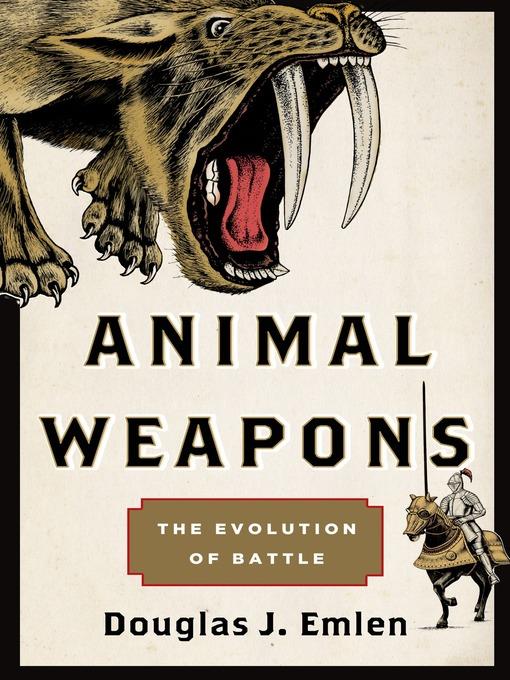
Animal Weapons
The Evolution of Battle
کتاب های مرتبط
- اطلاعات
- نقد و بررسی
- دیدگاه کاربران
نقد و بررسی

September 22, 2014
Emlen (coauthor of Evolution: Making Sense of Life) showcases his lifetime interest in weaponry in this work on the arms race in both the animal kingdom and the human world. Emlen begins by describing his curiosity with animal tusks and horns at the natural history museum as a child and goes on to describe the evolution of all manner of animal weapons, from the horns of his beloved dung beetles to the tusks of elephant species. He goes beyond mere description to illustrate why some species develop “extravagant weapons” while others do not. Emlen infuses scientific explanations with entertaining anecdotes from his field research at the University of Montana. Each step of the way, he provides parallels with human weapon development and design, from ancient civilizations to weapons of mass destruction, and the evolutionary process of animals. While his conclusions about the human arms race are dire, it is his description of animal weaponry in action and in evolution that will captivate. Agent: Tina Bennett, William Morris
Endeavor.

October 15, 2014
Emlen (Biology/Univ. of Montana) presents a bestiary equipped with outsize weaponry."What strikes us about antlers is that they are big," writes the author in this absorbing exploration of the exaggerated fighting instruments sported by animals and the uncanny ways in which they seem to march in lockstep with human weapons-up to a point. For the animals, it really comes down to sex; for the humans, it comes down to money. But Emlen is not a hurried or simplistic storyteller. He is a writer of nuance, and he traveled to many different environments to get the story. He prefers to meet the creatures on their own ground, to take in the habitat and consider the big picture. He introduces us to a pleasing variety of creatures, including sticklebacks, saber-toothed tigers, ibex rams, bamboo bugs and dung beetles, cuttlefish, alligator gar and porcupines, and he combs over their evolutionary advantages and disadvantages. It might seem obvious that an elk with a massive rack would be the king of the harem, but Emlen reminds us that the bull grows those monstrosities every year, and from his own bone. Just when his rack is ready for the rut, his skeleton is ready for rehab: "[A]nimal weapons under strong sexual selection, for example, may attain astonishing proportions before costs catch up and place the project in check." There are moose flies and harlequin beetles and fiddler crabs, which work mostly through threats, as well as the biochemical weapons deployed by skunks, polecats and stink bugs. Throughout the book, Emlen's demonstrations of the many parallels between human and animal weapons are fascinating, even when the possibilities are frightening. "I stand awed and shaken," he writes, "thrilled by the parallels and, at the same time, terrified by the prospects." Solid natural history, along with a well-turned thought or two about when weapons spell their owner's doom.
COPYRIGHT(2014) Kirkus Reviews, ALL RIGHTS RESERVED.

Starred review from September 1, 2014
Deer with magnificent antlers are disadvantaged in that they must find more food and expend more energy carrying around these heavy weapons than other deer. Antler growth can leach nutrients from other bones causing seasonal osteoporosis; the benefit is that other animals are deterred by the antlers, reducing the need to engage in conflict. In this title, Emlen (biology, Univ. of Montana; Evolution) compares the selection for large antlers to an arms race among governments--during the Cold War, for example. Beginning with camouflage and ending with weapons of mass destruction, the author juxtaposes the evolution of the armaments of the animal kingdom with those of humankind. Seamlessly inserted in the book are Emlen's own adventures conducting scientific research on beetles, eye-opening accounts that could inspire future scientists to follow in his footsteps. VERDICT Emlen's excellent writing will draw in readers intrigued by astonishingly powerful weapons, both in the wild and in the military, and how they have evolved owing to selective pressures. Though Philip Street's Animal Weapons describes a greater variety of animal defenses, Emlen's book is a more compelling read because it focuses on the parallels between animal and humans in this regard.--Laurie Neuerburg, Victoria Coll.-Univ. of Houston Lib.
Copyright 2014 Library Journal, LLC Used with permission.

October 1, 2014
The impulses that cause massive bighorn sheep to collide or miniscule army ants to maraud are much the same as those that drive humans to develop and use ever more sophisticated levels of weaponry. Spurred by a need to defend life-sustaining resources or a desire to attract life-creating mates, humans, animals, reptiles, birds, and insects all manufacture and refine systems of self-defense that encompass everything from the bizarre to the brilliant. For most, these methods of protection are camouflaged or insignificant, but occasionally an example emerges of arms in the extreme: gargantuan antlers, colossal claws, behemoth tusks. In humans, this compulsion to outdo has morphed from the simple spear to the nuclear bomb. From crabs to caribou, knights to navies, Emlen probes the reasons behind the bigger is better philosophy, weaving an interspecies saga of primordial urges that blends the worlds of biology and battleships, anthropology and aggression to philosophically ponder the illogical conclusion to which such competitiveness may lead.(Reprinted with permission of Booklist, copyright 2014, American Library Association.)

























دیدگاه کاربران